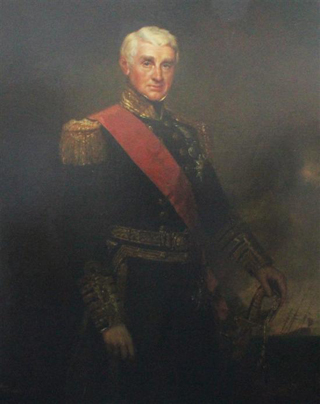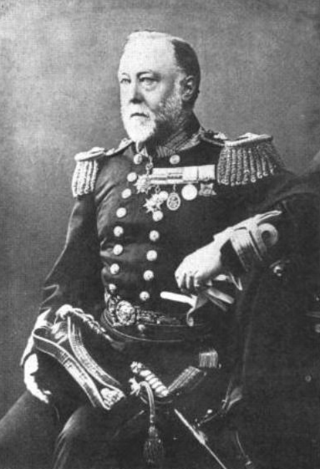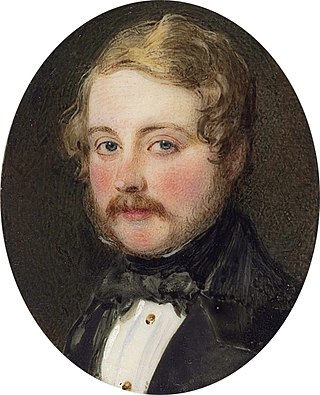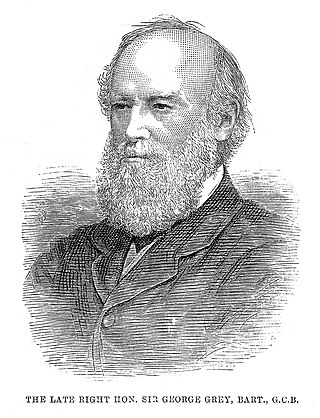Admiral Sir William Fanshawe Martin, 4th Baronet,, was a Royal Navy officer. As a commander, he provided valuable support to British merchants at Callao in Peru in the early 1820s during the Peruvian War of Independence. He became First Naval Lord in the Second Derby–Disraeli ministry in March 1858 and in that capacity acted as a strong advocate for the procurement of Britain's first ironclad warship. He went on to be Commander-in-Chief, Mediterranean Fleet and in that role provided important assistance during the Italian disturbances in 1860 and 1861, reformed the system of discipline in his fleet and developed a comprehensive system of manoeuvres for steam ships.

Admiral Arthur William Acland Hood, 1st Baron Hood of Avalon, was an officer of the Royal Navy. As a junior officer he took part in the capture of Acre during the Oriental Crisis in 1840 and went ashore with the naval brigade at the defence of Eupatoria in November 1854 during the Crimean War. He became First Naval Lord in June 1885 and in that role was primarily concerned with enshrining into law the recommendations contained in a report on the disposition of the ships of the Royal Navy many of which were unarmoured and together incapable of meeting the combined threat from any two of the other naval powers : these recommendations were contained in the Naval Defence Act 1889.

Admiral of the Fleet Sir Thomas John Cochrane, was a Royal Navy officer. After serving as a junior officer during the French Revolutionary Wars, he captured the French ship Favourite off the coast of Dutch Guiana and then took part in various actions including the capture of the Virgin Islands from Danish forces, the capture of the French island of Martinique and the capture of the French archipelago of Îles des Saintes during the Napoleonic Wars. He also took part in the burning of Washington and the attack on Baltimore during the War of 1812.

Admiral Sir John Charles Dalrymple-Hay, 3rd Baronet, was a Royal Navy officer and politician.
Rear Admiral Sir William Saltonstall Wiseman, 8th Baronet KCB was a British naval officer.

Admiral Sir Baldwin Wake Walker, 1st Baronet, was Surveyor of the Navy from 1848 to 1861. and was responsible for the Royal Navy's warship construction programme during the 1850s naval arms race and at the time of the introduction of the Ironclad warship; it was his decision to build HMS Warrior. He was created 1st Baronet Wake Walker, of Oakley House in 1856.

Admiral Sir William Milbourne James, was a British naval commander, politician and author. He served in the Royal Navy from the early 20th century to the Second World War. During the First World War, he was an integral part of the Naval Intelligence Division in its early years.

Admiral Sir Frederick Hew George Dalrymple-Hamilton, KCB was a British naval officer who served in World War I and World War II. He was captain of HMS Rodney when it engaged the Bismarck on 27 May 1941.

Admiral Sir Compton Edward Domvile, was a distinguished Royal Navy officer in the Edwardian and Victorian eras.

Admiral Sir Henry Fairfax was a Royal Navy officer who went on to serve as Commander-in-Chief, Plymouth.

Admiral Sir Michael Culme-Seymour, 3rd Baronet, was a senior Royal Navy officer. On 17 September 1880 he became 3rd Baronet, on the death of his father. The Culme-Seymours were relatives of the Seymour family, his father having added his wife's family name – Culme – to his own following her death.
Vice Admiral Sir John Chambers White, KCB was a prominent British Royal Navy officer of the early nineteenth century, who participated in a number of engagements during the Napoleonic Wars. He achieved most of his fame in the late 1790s as the commander of HMS Sylph, a small brig operating in Northern European waters. White was able to capture a number of equivalent French, Spanish and Dutch vessels and on one occasion was instrumental in the destruction of a much larger French frigate by a British squadron. In 1798 he was with the squadron that discovered the French invasion attempt on Ireland and acted as a messenger in the campaign to destroy the invasion force that ended at the Battle of Tory Island. He was later flag captain for Sir John Borlase Warren and participated at the action of 13 March 1806 and the destruction of the Regulus in 1814. After the war, White largely retired, but retained several shore appointments and rose to the rank of vice-admiral.

Sir Henry Hervey Bruce, 3rd Baronet PC (Ire) was an Irish Conservative politician. He was Member of Parliament for Coleraine from 1862 to 1874, and from 1880 to 1885.
Admiral Sir George Ommanney Willes was a Royal Navy officer who went on to be Commander-in-Chief, Portsmouth.
Admiral Sir William James Hope-Johnstone KCB was a Royal Navy officer who became Commander-in-Chief, The Nore.
Admiral Sir Geoffrey John Audley Miles, KCB, KCSI was a senior Royal Navy admiral who served as Deputy Naval Commander, South East Asia Command under Lord Mountbatten during the Second World War, as the Senior British Representative on the Tripartite Naval Commission and as the last Commander-in-Chief, Indian Navy of the unified Royal Indian Navy.

Sir George Grey, 1st Baronet, was a British Royal Navy officer and a scion of the noble House of Grey who served as Master and Commander of the Mediterranean Fleet. He joined the Royal Navy at the age of 14 and was on active service from 1781 to 1804, serving in the American War of Independence, the French Revolutionary War and the Napoleonic War. He served as Flag Captain for John Jervis, Earl of St Vincent and later as Flag Captain for King George III on his royal yacht. From 1804 to 1806, he was Commissioner at Sheerness Dockyard, and from 1806 until his death in 1828 he was Commissioner at Portsmouth Dockyard.

Admiral Sir Henry Edwyn Stanhope, 1st Baronet was a Royal Navy officer who became Commander-in-Chief, The Nore.
Sir Henry Hervey Aston Bruce, 1st Baronet was an Irish priest.
Admiral Sir Alexander Leslie Montgomery, 3rd Baronet was a Royal Navy officer.













